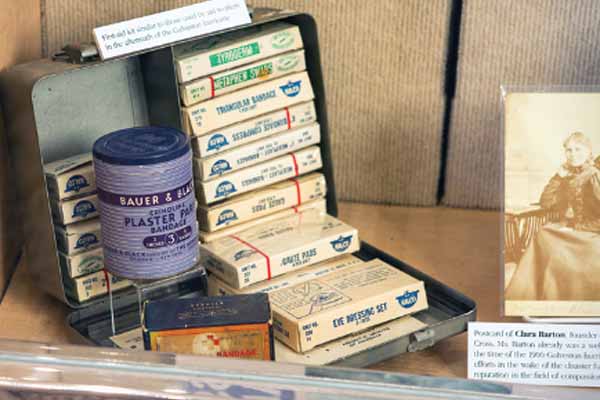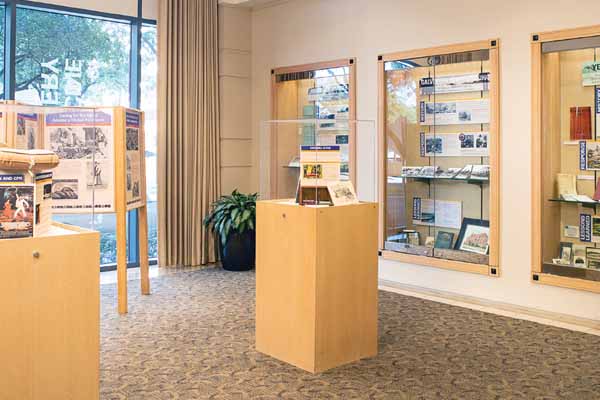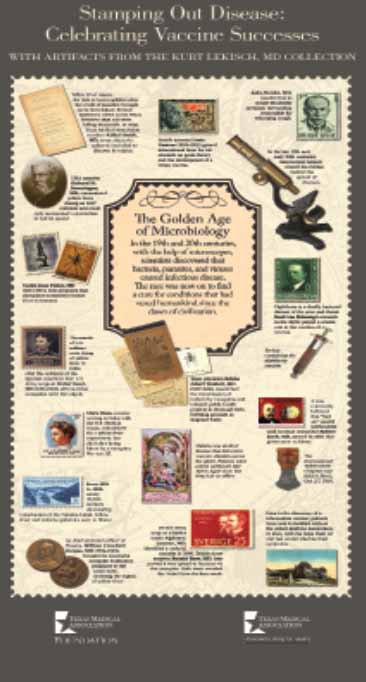
For decades, the fifth floor of the Texas Medical Association building in Austin had housed an archival collection of thousands of books, photographs, and artifacts documenting the rich history of Texas medicine.
One day in October 2018, there it was, like buried treasure: TMA staff found a hand-written letter from 1892 tucked in the pages of an old medical journal.
Its author was Texas physician John Wesley Carhart, MD. The letter, which discusses the surgery of a 10-year-old boy who had been suffering from a brain tumor, would form the basis of a speech the general practitioner presented to TMA that year on the topic.
Now logged in the archive, the speech gives modern-day physicians a look at the tools and techniques surgeons used more than 100 years ago.
TMA’s 1991 move to its current home on 15th and Guadalupe streets in Austin presented a world of similar treasure-trove moments, and the association soon realized the potential they held.
In particular, the building committee weighed what to do with the first floor, which would host visitors from membership and the public. Elgin W. Ware Jr., MD, a Dallas urologist, had a novel idea: The space could be used to educate guests about the role physicians played in Texas history, using artifacts then held in the TMA library.
To curate that space, the Board of Trustees appointed a History of Medicine Committee, chaired by Dr. Ware, making Texas physicians archivists of their own past. Now 35 years on, hand in hand with the TMA Knowledge Center, the long-range plans developed at the committee’s first meeting continue to come to fruition.
Among those plans: position TMA as a leading authority on the history of medicine in Texas; produce traveling exhibits; and work with staff to preserve records that tell the story of the association, including making a permanent collection for TMA presidential papers and an oral history of past presidents.
“There’s this story of Texas history that can be told through the lens of health care and health care delivery that is very important to understand why we are where we are today in health care in Texas,” said Steve Steffensen, MD, an Austin neurologist and member of the committee. “TMA’s collection is very intentional toward the creation of a historical accounting of health care in Texas. That, to my knowledge, does not exist anywhere else.”
That history is particularly prescient for current committee chair J. Marvin Smith III, MD, a thoracic surgeon from San Antonio. His father, J. Marvin Smith Jr., MD, a past chair of the TMA Board of Trustees, knew the association would continue to grow with Texas and was the first to suggest creating the trust that served as TMA’s nest egg for expanding into a larger building and, now, for renovating it.
“Part of my interest in history is having that tradition behind me,” said Dr. Smith, who traces his family’s Texas roots to commanders in the Battle of San Jacinto in 1836.
But it’s the Texas medical tradition, too, in which Dr. Smith takes pride, such as landmark accomplishments in his specialty, heart surgery. Texas has a special place in leading medicine, he says.
“I was fortunate enough to have a residency with Denton Cooley, MD, who was really one of the giants in the field of cardiovascular surgery and medicine. It’s pretty dramatic when you stop and think of the history of that sort of surgery within Texas. You had Dr. [Michael E.] DeBakey and Dr. Cooley both, the Texas Heart Institute being a shining beacon in education and creation, and then also the Baylor College of Medicine,” he said. “And the two of them are right across the parking lot from one another. It’s pretty phenomenal that that much, that great of success, occurred in such proximity with one another.”
It’s not just scientific successes that spark Dr. Smith’s pride. Texas physicians have historically fought for policy changes that ensure access to quality care – famously, medical liability reform in the early 2000s and, earlier, helping to form what is now the Texas Medical Board, formerly the Texas Board of Medical Examiners.
“If you go back and review history, you see it was often doctors, and, I would say more often than not, doctors who were members of the Texas Medical Association, who took it upon themselves to promote public health within the state,” he said. “Those things are important contributions of doctors and may be overlooked by other people.”

Banner years
As a large part of commemorating those accomplishments and true to its roots, the History of Medicine Committee oversees the creation of gallery and traveling exhibits as well as regularly hosts the public annually on Austin Museum Day.
Following its inaugural exhibit in 1991, “Technology in Medicine: 150 Years of Medical Innovation,” the Robert G. Mickey History of Medicine Gallery, named for the former TMA executive vice president who suggested the committee’s creation, has told story after story of Texas history through medicine. For example, “Stamping Out Disease” illustrated the fight against infectious disease through postage stamps collected by the late TMA member Kurt Lekisch, MD, and “Smoke and Mirrors” traced the history of tobacco and medicine.
“For the public, especially [those] interested in the future of health care in Texas, one of the better ways to improve the future of health care in Texas is to understand the past, and TMA has a wonderful collection to help understand that,” Dr. Steffensen said.
The gallery is in transition as TMA headquarters undertakes yet another building milestone, renovating the Louis J. Goodman building. The refurbishment presents new opportunities for archive management and gallery upgrades. In the meantime, the committee continues to recommend members take advantage of TMA’s traveling banner exhibits.
Each banner takes images and descriptions of key artifacts from a given exhibit and consolidates them into a more portable form, able to be rolled up and shipped. Thanks to funding from the TMA Foundation, banner exhibits have shipped, free of charge, to vaccination sites, physicians’ offices, and medical schools. They’re also used by the organization; the Women Physicians Section displays the “Women in Texas Medicine” banner exhibit at meetings, for instance.
Similarly, TMA has received requests to use certain banners to commemorate special dates – such as “Courage and Determination,” an exhibit on Black physicians, being requested for Black History Month, or the “Women in Texas Medicine” banner for Women in Medicine Month.
The banner exhibits are also unique in that they can be translated into other languages. While pricey, doing so can have ripple effects on public health and community trust in medicine. TMA has translated into Spanish its “Stamping Out Disease” banner on infectious disease and vaccination and its “Deep Roots” banner on botanical medicine and prescriptions.

Building on a foundation
None of these projects would be possible without the robust collection of the TMA archive. From decades’ worth of House of Delegates business to medical devices and doctors’ bags, across eras, locations, and fields of medicine, the archive is full of “snapshots” of Texas medical history, Dr. Steffensen says. (See “Living Legacy,” page 18.)
In addition to information-themed exhibits, the archive’s artifacts may be used in teaching medical students. Medical history researchers and genealogists can access the archive on an appointment basis too.
“TMA’s collection is an important piece of a larger puzzle of understanding health care in Texas,” Dr. Steffensen said. “Without that piece, I don’t think you can fully appreciate the history of health care in Texas.”
Besides its public-facing role, the archive also serves a vital role internally.
As TMA boards, councils, and committees put together policy, learning from precedent over the association’s 170-year history is crucial. The archive serves as a resource in developing or updating policy and houses over a century’s worth of House of Delegates transactions that track how a policy has changed with time and why.
As the medical landscape changes, Dr. Steffensen says the committee’s mission of a comprehensive and comprehensible collection changes shape too.
“I look around at the next generation of physicians, the medical students that I teach at the medical school – so much of how they learn and interact and engage with the health system is in a digital environment,” he said. “How do you begin to catalog and archive that aspect without losing the importance of that physical nature of health care?”
To start, TMA has begun digitizing existing artifacts where appropriate, as determined by the committee, as well as incorporating more technology and perhaps interactive elements into future displays. The undertaking is expensive and requires serious deliberation, says Dr. Smith, but the challenges carry with them excitement as another chapter of TMA’s history unfolds in its new home.